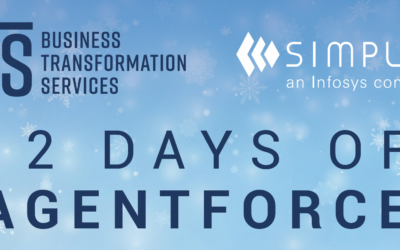A C-Suite Guide
This three-part series will cover some key decision factors that can help avoid unnecessary costs in a Salesforce digital transformation project.
A digital transformation is a significant undertaking for any business. If your company is in the planning stages, there are several elements you need to consider when determining ROI. An accurate estimate of costs is the foundation of an ROI calculation, but it can be a difficult number to get. Any transformation is going to involve multiple systems, several phases, and many stakeholders.
It’s no secret that a digital transformation initiative can add up dollars fast. And you’ll likely be pushed to find ways to reduce those costs before getting the green light. But how do you cut costs without compromising the end goals of transformation?
First, figuring out software licensing is a great first step to minimizing the cost of your digital transformation. You can often get very accurate numbers for the different platforms as long as you have good data around user counts. Next, you will want to get several estimates from implementation and consulting partners. This is a good way to set baseline expectations on cost and timeline. Finally, you need to calculate the internal costs that will impact your team. If you need additional headcount, such as a dedicated project manager or internal administrator, you can add that to your anticipated costs.
Of those three areas, the one with the greatest potential for variance is the implementation and consulting costs—from implementation methodology and partners to expertise and accelerators. That is where we will focus this series. First, let’s look at implementation methodology as an area for reducing costs.
Factor #1—Implementation Methodology
When you are assessing a potential implementation partner, one area to consider is their implementation methodology. The way a company implements software can have a massive impact on the budget and timeline.
There are three primary methodologies used in development: agile, waterfall, and hybrid. Each has benefits and drawbacks. It’s important to take a close look at your organization and make sure the implementation method is aligned with your overall strategy. Companies that do so by performing benefits realization management see a 58 percent increase in projects that are completed on time and a 43 percent increase in those that are completed within budget.
Let’s dive into each implementation methodology and explore its value.
Agile
Agile is the standard for software development, with “71 percent of organizations now reporting they use agile approaches to their projects sometimes or more frequently than in the past.” Many companies enjoy the benefits of this methodology internally. The core tenet of agile is the ability to develop and release on a regular cadence rapidly. A backlog of development items exists and can have items removed, added or reprioritized as required by the business (hence the term agile). In regular sprints, developers work through specific backlog items. These follow a build, test, deploy pattern.
While this offers very rapid development and the ability to change and adapt quickly, this methodology has a few critical drawbacks with regards to a digital transformation. The largest is that agile cannot function with a defined budget and timeline.
Backlog items are developed during sprints, but due to the flexibility of the methodology, it doesn’t function well with strict timelines. This makes it very difficult to use in an implementation. Almost any project of this nature relies on a defined set of deliverables, within a specific timeframe, and on an agreed budget.
Waterfall
Waterfall is more standard for implementation projects. It is based on defined stages that progress in a linear fashion (hence the term waterfall). As with a waterfall, you can only move one direction; you can’t move back to a previous stage.
This methodology typically features the following phases:
- Analysis – Requirements are gathered, user stories are created
- Design – The user stories become technical requirements
- Implementation – The actual development and configuration
- Test – Testing is performed, typically quality assurance and user acceptance
- Deploy – The system goes live
- Maintain – Support and training are provided
Depending on the organization, these phases may be combined or feature different labels. The key benefit to waterfall is that the requirements are defined, making it possible to set a defined budget and schedule.
The key drawback to waterfall is that the development happens with little visibility. An implementation partner will code and configure in one long phase, meaning that you don’t get to see the work until the user acceptance testing phase. This can lead to unexpected costs when the delivered product doesn’t match expectations.
Hybrid
Hybrid methodology combines both agile and waterfall, and about one in five project managers say they use this approach. It uses the waterfall phases to gather defined requirements, set a timeline and deployment date. But when it comes to the implementation phase, it transitions to an agile delivery. This involves sprints that have a rapid develop, test, demo strategy, making it easy for your company to view progress and provide feedback.
Simplus uses a hybrid methodology because it combines the best of both worlds. We rely heavily on user feedback to deliver projects with a high adoption rate. Having involvement throughout a project is a crucial factor in user adoption.
This also introduces some flexibility in the development phase. Items in the development plan can be reprioritized or modified within specific parameters. New items can’t be added to the backlog without removing others, but this does let the consultants and users collaborate to achieve the best results.
One factor in effectively leveraging a hybrid methodology is the amount of adherence to agile during the implementation phase. Some projects are not a good fit for agile development. Platforms or tools that have a large number of interdependencies don’t fit well. When it isn’t possible to break down functional items, less adherence to traditional agile is preferred.
Key Takeaway
The main item to understand is that the way a partner approaches a project has a tremendous impact on the final product. When assessing potential partners, ask them about their methodology. Dig in to understand how they approach things, and what they think is best for your project. You will quickly be able to qualify/disqualify when you really dive in.
Getting both parties on the same page will help you approach your transformation project with proper expectations. Using a suitable methodology and partner will help you avoid rework, stick to a timeline and budget, and achieve your goals.















0 Comments